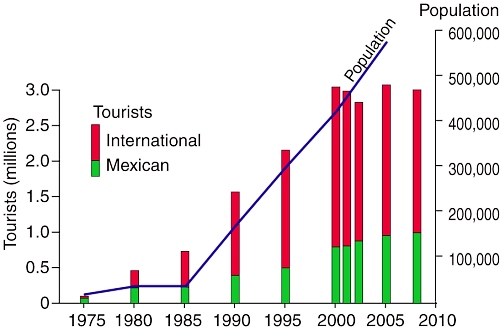Mexico’s mass tourism industry in the past forty years has been dominated by large-scale, purpose-built developments partially funded by federal funds. In 1967, responding to bullish predictions of US demand for beach vacations, Mexico’s central bank identified the five best places for completely new, purpose-built tourist resorts. Top of the list, as part of a 30-year plan, was the uninhabited barrier island now known as Cancún. The other choice locations were Ixtapa, Los Cabos, Loreto and Huatulco.
The National Fund for Tourism Infrastructure (renamed the National Tourism Development Fund, Fonatur, in 1974) began building Cancún in 1970 and Ixtapa in 1971.
Cancún has become Mexico’s foremost tourist resort. Factors considered in the choice of Cancún included water temperatures, the quality of beaches, varied attractions, sunshine hours and travel distances from the main markets. The stated benefits were thousands of new jobs, increased revenues, the development of a previously peripheral region and the diversification of the national economy.
Public funds were used to purchase land, improve it by fumigation and drainage, and install all necessary basic infrastructure (airport, highways, potable water, electricity, telephone lines, convention center, golf course, harbors). Private sector investors developed hotels, a shopping center and supporting services.
By 1975, Cancún had 1769 rooms in service; by 2008, it boasted about 150 hotels and more than 27,000 rooms. Second only to Mexico City, Cancún airport now handles 200 flights a day. The influx of people to Cancún has been especially dramatic. The city has had to cope with unprecedented growth rates as its population shot up from 30,000 in 1980 to 676,238 in 2010 (preliminary census figure) (see graph).
The number of tourists in Cancún dipped slightly in 2001–2002 due, in part, to the 2001 9/11 tragedy in the USA. Hurricane Wilma (2005) put many hotel rooms temporarily out of commission. Cancún is now only one focus of an extensive tourist corridor along the Quintana Roo coast, stretching as far south as Tulum.
Chapter 19 of Geo-Mexico: the geography and dynamics of modern Mexico, from which this extract is taken, looks in much more detail at Mexico’s purpose-built resorts as well as many other aspects of tourism, resorts and hotels in Mexico.
2 Responses to “The growth of Cancún, Mexico leading tourist resort”
Sorry, the comment form is closed at this time.

hi guys, can anyone email me a table of tourism numbers in cancun from 2000-2013?
Give us a day or two to see what we can find…
Have emailed you the relevant numbers; don’t forget to credit Geo-Mexico!